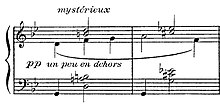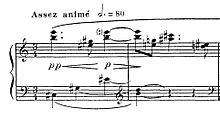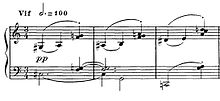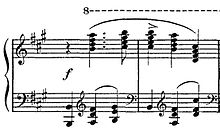Valses nobles et sentimentales
Valses nobles et sentimentales (French: noble and soulful waltz ) is a piano work by the French composer Maurice Ravel . The suite, consisting of eight waltzes, was published for piano in 1911; a version for orchestra followed in 1912. The work is dedicated to the French pianist and composer Louis Aubert , who premiered it on May 9, 1911 in Paris.
As with Ravel's early work Jeux d'eau , the publication took place with a quote from the poet Henri de Régnier : “[…] le plaisir délicieux et toujours nouveau d'une occupation inutile” (translated roughly: The delicious and ever-new pleasure of a useless one Activity ).
Emergence
Ravel took up the idea for a suite of waltzes from Franz Schubert , who, however, composed two groups from Valses nobles and Valses sentimentales . Although Ravel had started work on his orchestral work La Valse in 1906, it was not published until 1919. The suite Valses nobles et sentimentales gives a foretaste of Ravel's love for the genre of the Viennese waltz and, above all, his characteristic tonal language. Many of the motifs from the suite were also used in the finished version of La Valse . After his highly virtuoso piano work Gaspard de la nuit , the composer wanted to create an orchestral sound with the Valses that impresses more through clarity and transparency than through virtuosity. Nevertheless, Ravel considered the Valses nobles et sentimentales to be one of his most difficult works to interpret.
The premiere in 1911 by Louis Aubert in the Salle Gaveau took place as part of an event organized by the Société musicale indépendante , at which various works were presented whose composers were initially unknown to the public. This should allow every artist an impartial assessment. Due to their dissonances and daring harmonies, the Valses nobles et sentimentales caused little enthusiasm among the audience. There were a few interjections, and in some cases the work was even mistaken for a parody. In the subsequent vote as to which composer it could be, names such as Erik Satie and Charles Koechlin were used . The narrow majority, however, came to the conclusion that it must be a work of Ravel.
structure
The work consists of seven waltzes with independent themes and an epilogue which, in addition to a recurring main theme, processes the preceding waltzes. All pieces belong to the genre of the Viennese waltz and are therefore notated in ¾ time. As usual with Ravel, the text contains numerous instructions for speaking.
Due to the fluid transitions of the waltzes and the framing function of the epilogue, the suite cannot be separated. A selective performance of individual waltzes is thus excluded.
A typical recording of the Valses nobles et sentimentales takes about 15 minutes.
1. Modéré - très franc, G major (French: moderate - very free / open )
The suite opens with an elegant and modern waltz. Already the first two bars announce how little Ravel's understanding of harmony corresponds to that of Schubert. In contrast to what is customary in a classic Viennese waltz, Ravel did not emphasize the first but rather the third beat. Combined with the strong dissonance of these chords, a completely unfamiliar and modern idea of the waltz is conveyed.
This waltz can be thematically divided into the ABA scheme. The first part of the piece is characterized by elegance and vitality, with performance titles that extend to fortissimo. The middle section is a play between crescendo and diminuendo. A calm, mysterious mood is developed, only to be broken up by the dissonant main theme. The waltz closes with a thematic repetition of the introduction.
This first waltz clearly shows that Ravel (unlike Schubert) did not want to classify the waltzes clearly into the categories “noble” or “sentimental”. Rather, both elements are linked to one another. Difficulties in the piece include, among other things, long jumps, large grips for the right hand, in which the thumb hits two keys at the same time and all of this at a brisk pace.
2. Assez lent - avec une expression intense, G minor (French: fairly slow - with an intense expression )
The second waltz is characterized by an almost intoxicating calm atmosphere. While rapid changes in dynamics occur in the first waltz, waltz II is characterized by a thoroughly relaxed mood that only goes into forte in the finale. The piece consists of three themes that can be combined to form ABAC.
The explicit instruction rubato is particularly unusual for Ravel . In contrast to some composers of the Romantic era, what is meant here is a rubato, which is still manageable and has a certain framework. Ravel makes this intention clear by spelling out the rubato with short grace notes ( acciaccatura ).
The main difficulty of the piece is to create a calm and mysterious atmosphere and at the same time to let the exotic harmonies "breathe" even in pianissimo.
3. Modéré, E minor
The third waltz is based on a simple, playful main theme that is varied throughout the piece. Similar to the first waltz, the staccato designation of the third beat creates a rhythm that is atypical for Viennese waltzes.
During the third waltz, the third beat has to be isolated all the time, usually at a moderate volume. Above all, this requires safe use of the pedals.
4. Assez animé, C major (French: quite lively )
The fourth waltz has a lively character and is characterized by unusual harmonies. Here, too, the main theme is consistently applied in various forms.
The difficulty of the waltz lies in a fluid and lively performance of the sometimes very tight chord changes. Here the right hand has to change its position quickly and constantly by a few keys, which requires a certain fine motor skills.
5. Presque lent - dans un sentiment intime, E major (French: almost slowly - in an intimate feeling )
As with Waltz II, a classification as Valse sentimentale is obvious. The fifth waltz once again presents mysterious and colorful harmonies carried by a calm tempo.
According to his own statements, Ravel wanted to create a waltz based on Schubert's model with this piece. Thus, when performing the fifth waltz, it is particularly important to ensure that the upper voice is held continuously and emphasized by singing. In view of the sometimes unusual chords, this can result in uncomfortable fingering.
6. Vif, C major (French: living )
The short sixth waltz is characterized by daring dissonances and sudden changes in tempo. It consists of a main theme that experiences different variations.
Waltz VI poses problems, especially in terms of rhythm. Constant changes from legato, staccato and arpeggiated chords promote the vibrating dynamics of the work. There are also quick, long jumps with the left hand.
7. Moins vif, A major (French: less lively )
The seventh waltz is the longest lyrically in the suite. He processes the largest range of motifs to date and also has a special position in terms of technical difficulty. Of all the waltzes, Ravel considered the seventh to be the most full of character.
A structure of ABA can be clearly seen. The waltz begins with a mention of waltz VI above. The independent theme slowly develops in pianissimo. Soon afterwards this is presented by the left hand as a mature main theme, still in pianissimo. After a large crescendo, a powerful climax is finally reached in fortissimo. A lively, flowing middle section follows. This is particularly characterized by acrid dissonances from the left hand. The piece ends with an absolute repetition of the first part.
The large jumps of both hands at high speed require the pianist to be able to coordinate safely. Other problems are the design of the dynamics and wide grips.
8. Epilogue: Lent, E minor
Right at the beginning, the epilogue presents a dark, simple main theme that recurs in different keys throughout. Motifs from the previous waltzes are continually taken up, which ultimately lead to the melancholy theme of the epilogue. Waltz V alone is not mentioned.
The main difficulty of the epilogue lies in elegantly enveloping the varied themes of the previous waltzes in the melancholy main theme. Sometimes it is only possible to fully comply with Ravel's instructions with the sostenuto pedal.
Significance in the overall work
A large number of musicians from Ravel's circle of friends attribute a special position to the suite in the composer's main work.
The music critic and Ravel biographer Alexis Roland-Manuel classifies the Valses nobles et sentimentales , alongside the Trois poèmes de Stéphane Mallarmé (published 1913) and the piano trio in A minor (1914), as the masterpiece in the composer's oeuvre. Roland-Manuel explains that with the suite Ravel had created a palette of harmony that would be important for all of his subsequent works.
Two pianists, who personally rehearsed Ravel's entire piano work with the composer, associate particularly formative memories with the waltz suite. According to Vlado Perlemuter , the composer did not try so passionately in any other of his works to convey a correct interpretation of the text.
The French pianist Henriette Faure (1904–1985) reports on a similar experience. For them, according to their own statement, the prelude to the Valses nobles et sentimentales became two and a half hours of torture due to the pedantic instructions of Ravel.
The Valses are one of the few piano works that Ravel, who himself was a passable pianist, recorded entirely through Welte-Mignon .
Recordings
Numerous great pianists of the 20th century included the Valses nobles et sentimentales in their repertoire. The following recordings deserve special mention:
- Martha Argerich - 1975 - Deutsche Grammophon.
- Arturo Benedetti Michelangeli - 1952 (live) - Praga Digitals.
- Vlado Perlemuter - 1973 - Nimbus Records.
- Maurice Ravel - 1913 (Welte-Mignon) - Laser Light.
- Sviatoslav Richter - 1954 (live) - Parnassus Records.
- Arthur Rubinstein - 1963 - RCA Red Seal.
Orchestral version
In 1912 Ravel submitted an orchestral version for ballet. It was titled Adélaïde, ou le langage des fleurs (French: Adélaïde, or the language of flowers ). The plot tells the story of a young Parisian woman in 1820 who is courted by various men. The central emotions such as hope, love and rejection are symbolized by the use of different plants.
Ravel planned the following line-up for the orchestra: flute (2), oboe (2), cor anglais, clarinet (2, in Bb and A), bassoon (2), horn (4, in F), trumpet (2), trombone (3), tuba, timpani, tambourine, cymbals, snare drum, bass drum, glockenspiel, triangle, celesta, harp (2) and string instruments.
literature
- Henriette Faure: Mon maître Maurice Ravel . Les Editions ATP, Paris 1978, ISBN 2-85951-020-6 .
- Arbie Orenstein: A Ravel Reader. Dover Publications, New York 2003, ISBN 0-486-43078-2 .
- Arbie Orenstein: Ravel - Man and Musician. Dover Publications, New York 1991, ISBN 0-486-26633-8 .
- Vlado Perlemuter / Hélène Jourdan-Morhange: Ravel according to Ravel. Translated by Frances Tanner. Kahn & Averill Publisher, London 1989, ISBN 1-871082-78-1 .
- Roland-Manuel: Ravel. Athenaion publishing house, Potsdam 1951.
Web links
Individual evidence
- ^ A Ravel Reader. P. 31.
- ^ A Ravel Reader. P. 290.
- ^ A Ravel Reader. P. 31.
- ^ Roland-Manuel: Ravel. P. 59.
- ^ Ravel - Man and Musician. P. 64.
- ↑ Ravel according to Ravel. P. 46.
- ↑ Ravel according to Ravel. P. 50.
- ^ A Ravel Reader. P. 31.
- ^ Roland-Manuel: Ravel. P. 119.
- ↑ Ravel according to Ravel. P. 43.
- ↑ Mon maître Maurice Ravel. P. 20.
- ^ Ravel - Man and Musician. P. 176.









